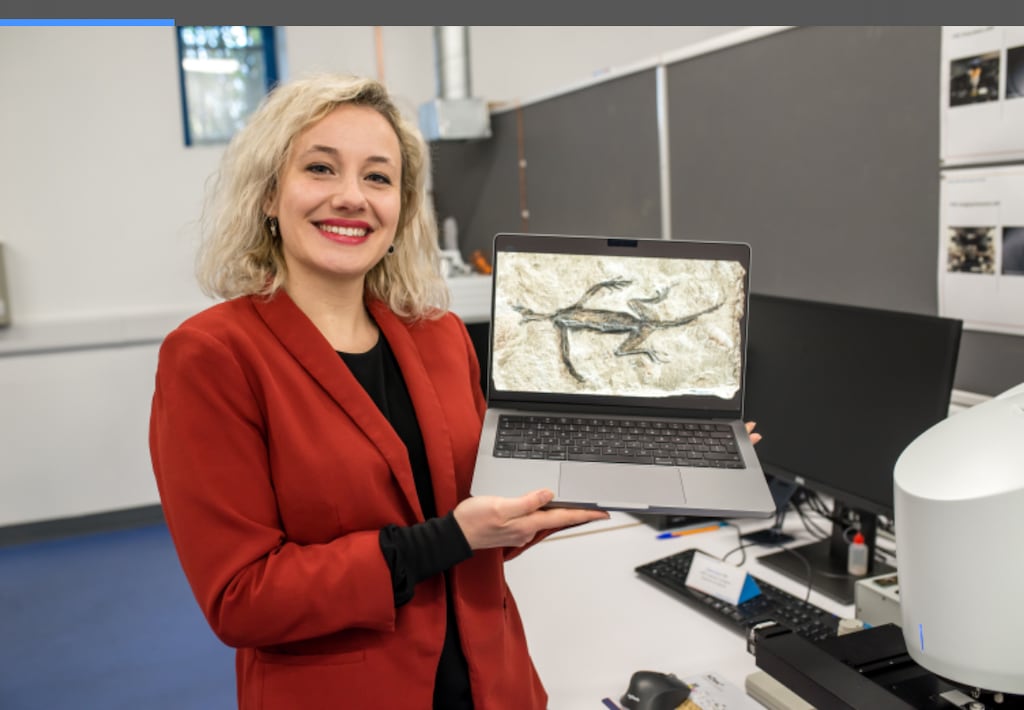A 280-million-year-old fossil that has baffled researchers for decades has been shown to be in part a forgery following new examination of the remnants.
The discovery has led the team headed by Dr Valentina Rossi of UCC to urge caution in how the fossil is used in future research.
Tridentinosaurus antiquus was discovered in the Italian Alps in 1931, and it was thought to be an important specimen for understanding early reptile evolution.
Its body outline, appearing dark against the surrounding rock, was initially interpreted as preserved soft tissues. This led to its classification as a member of the reptile group Protorosauria.
‘A guy who was well respected around town’: The catastrophic story of Custom House Capital and Harry Cassidy
From a conference to court: The Web Summit case begins
Why are so many recipients of US Medal of Honor of Irish descent?
Seán Moncrieff: The estate agent quoted a jaw-dropping figure for what he thought our house would go for
However, new research, published in the scientific journal Palaeontology, reveals the fossil renowned for its remarkable preservation is mostly just black paint on a carved lizard-shaped rock surface.
The purported fossilised skin had been celebrated in articles and books but never studied in detail. The somewhat strange preservation of the fossil had left many experts uncertain about what group of reptiles this strange lizard-like animal belonged to and more generally its geological history.
Dr Rossi – of UCC’s School of Biological, Earth and Environmental Sciences – said fossil soft tissues are rare, but when found in a fossil they can reveal important biological information.
“The answer to all our questions was right in front of us; we had to study this fossil specimen in details to reveal its secrets – even those that perhaps we did not want to know.”
The microscopic analysis showed the texture and composition of the material did not match that of genuine fossilised soft tissues.
Preliminary investigation using UV photography revealed the whole specimen was treated with some sort of coating material. Coating fossils with varnishes and/or lacquers was the norm in the past and sometimes is still necessary to preserve a fossil specimen in museum cabinets and exhibits.
The team was hoping that beneath the coating layer, the original soft tissues were still in good condition to extract meaningful palaeobiological information.
However, the findings indicate the body outline of Tridentinosaurus antiquus was artificially created, likely to enhance the appearance of the fossil. This deception misled previous researchers, and now caution is being urged when using this specimen in future studies.
The team behind this research includes contributors based in Italy at the University of Padua, Museum of Nature South Tyrol and the Museo delle Scienze in Trento.
Co-author Prof Evelyn Kustatscher – co-ordinator of the project Living with the supervolcano, funded by the Autonomous Province of Bolzano – said the peculiar preservation of Tridentinosaurus had puzzled experts for decades.
“Now, it all makes sense. What it was described as carbonised skin, is just paint.”
However all not all is lost, and the fossil is not a complete fake. The bones of the hind limbs, and the femurs in particular, seem genuine, although poorly preserved.
Moreover, the new analyses have shown the presence of tiny bony scales called osteoderms – like the scales of crocodiles – on what perhaps was the back of the animal.
This study is an example of how modern analytical palaeontology and rigorous scientific methods can resolve an almost century-old palaeontological enigma.
- See our new project Common Ground, Evolving Islands: Ireland & Britain
- Sign up for push alerts and have the best news, analysis and comment delivered directly to your phone
- Find The Irish Times on WhatsApp and stay up to date
- Our In The News podcast is now published daily – Find the latest episode here











